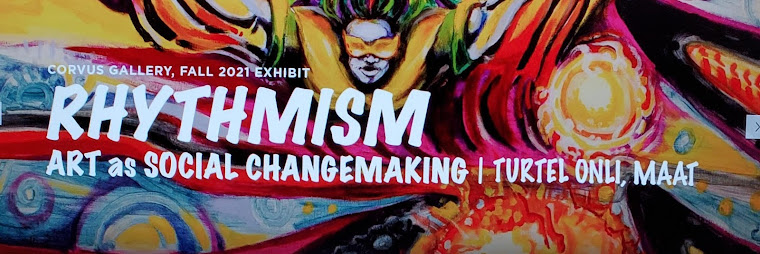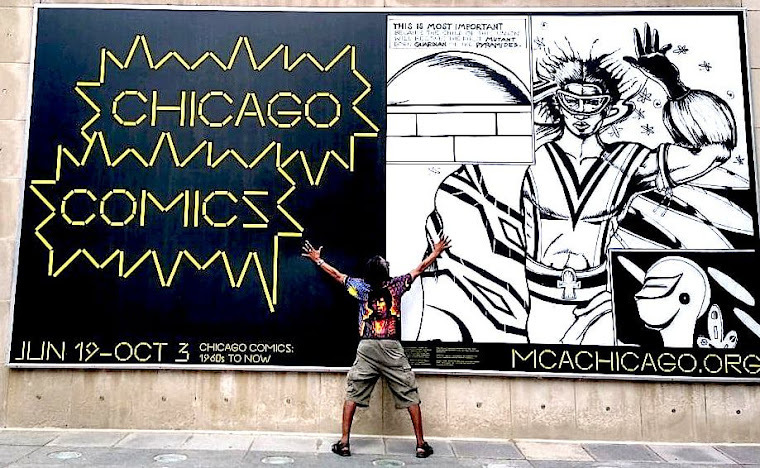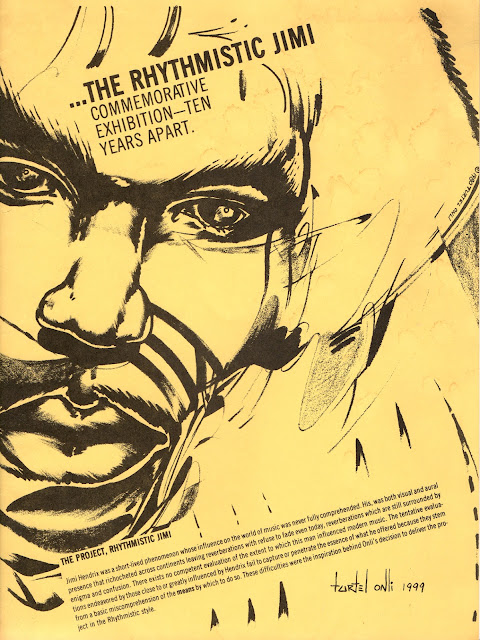
Afro Futuristic visual art is born of Rhythmism! Onli's Future-Primitif works have been shown to positive acclaim with The Museum of Contemporary Art, Chicago, Cool Globes, The Tubman Museum, New Museum of Contemporary Art, NY, The Krannert Museum, The DuSable Museum of Black History, The Museum of Science & Industry, Chicago Children's Museum, & The FIAP in Paris. Educators, enthusiasts, collectors, curators, collectors, & critics are.. WELCOME!
"NOG Emerges" 2021 Copyright 2021 Turtel Onli

Inspired by "NOG" being the Future-Primitif face of the blockbuster group exhibition at the change making, trend setting Museum of Contemporary Art, Summer / Fall 2021 called "Chicago Comics: 1960 Until Now", curated by Dan Nadel. . NOG was mural sized on the MCA's outer wall near the door to its Museum Store which featured NOG merchandise in the form of a Tote Bag, post cards, a ever-cool NOG Sketch Book, plus autographed copies of "Tales From The Rhyhthmic Zone", the Graphic Novel that includes expanded versions of the original NOG stories. So Rhythmistic! All artwork on this blog by Prof. Onli is Copyright 2023 Turtel Onli , and other dates. All Rights Protected & not to be remixed, rebooted or used commercially without a signed agreement with Prof. Onli.
Sunday, October 14, 2018
"Bolt" is a water-colour painting by Onli circa 1987. The cosmic expression in these Rhythmistic images, paintings and album cover shows the range of fine and commercial application of Afrofuturism.
This landmark group exhibition at the Tubman Museum in Macon GA was innovative and intelligent in its dynamic presentation of the Afrofuture aspects of artistic expression and practices.
"Mothers Earth" is a Rhythmistic painting on canvas by Onli, circa 1998.
Onli designed this album cover in 1978/79 for the funk-disco master Captain Sky. The flying intergalactic pyramid turn-table evoked the flow from the future that Onli started as
Rhythmism now is branded as Afrofuturism. There is always a history in the future.
This landmark group exhibition at the Tubman Museum in Macon GA was innovative and intelligent in its dynamic presentation of the Afrofuture aspects of artistic expression and practices.
"Mothers Earth" is a Rhythmistic painting on canvas by Onli, circa 1998.
Onli designed this album cover in 1978/79 for the funk-disco master Captain Sky. The flying intergalactic pyramid turn-table evoked the flow from the future that Onli started as
Rhythmism now is branded as Afrofuturism. There is always a history in the future.
Tuesday, September 18, 2018
It was the first time anyone compared and questioned the practices in the international fine art world that overlooked and marginalized Black Artists. It was stolen and suppressed so certain non-Black arts university professors, curators and art dealers could rule, control and exploit the remnants and aging Black artists from this practice.
Onli was a talented teenager zooming through all of this in the '60s & '70s. As a participant. Onli founded the Black Arts Guld when he was 18 and led it until he was 25. BAG, as it was known, was predicated on launching the professional careers of young talented Black visual artists. And it succeeded! Refusing to be denied or thusly exploited.
You deserve to know better!
-----------------------------------------------------------------------------------
Words and Pictures Sequential Arts Resource Page:
Definitions,
Extra Credit, Links,and FYI insights.
( Please note that all of the images that appear in this site were selected
for educational purposes and are not to be printed or used for commercial reasons.
They are copyrighted or trademarked by the creators, estates, or companies to
whom they are registered.)
Definitions:
Be sure to scroll the
entire page.
Art Elements:
Basic components that are used to create a work of visual art. This includes
color, line, shape,circle, space ,value, and form.Art Principles: The combination of art elements that give a work of art more sophistication. This includes perspective, proportion, movement, intensity, unity, pattern, texture, contrast, and rhythm.
Critique: A standardized evaluation.
Sequential Art: Drawings that are linked by a progression that follow or actually tells a story from start to finish. This is typical of movie story boards and comic books.
Surrealism: A style of art that was created in the early 20th century based on images that were derived from the subconscious or dream state of the human mind. Surrealists often depicted dreamscape environments, transmuted creatures, and ironic concepts. This type of work required a practiced disciplined technical ability to produce convincing results and effects. It was a reaction to the idea that artwork should be based on the real world as we normally experience it. Salvador Dali became the most effective of the surrealists by using the concepts of psychiatry in a lot of his artwork. This "inner world" was presented in the groundbreaking psychoanalytical research of Sigmund Freud.
Heavy Metal Music: A music form that was created in the late '60s that was based on the intense application of electrified and distorted sound, powerful cord progressions, pulsating rhythms, screaming vocals, and extravagant stage shows. The music was derived from concepts found in the Blues, Classical, and Folk music. It epitomized the idea of a growing counter-culture that could be as viable as mainstream society. A writer for the Rolling Stone magazine first used the term "heavy metal music" to describe a performance by the Jimi Hendrix Experience rock band. This is reported to be gleaned from its earlier use in author WIlliam S. Burroughs' book, "The Naked Lunch" which conveyed insightful passions of the "Beat Generation".
Rhythmism: An approach to creating art that draws its energy from the primitive-tribal past and projects that influence into a contemporary or futuristic context. It includes fine, esoteric, professional, or commercial art forms. The term was coined by Turtel Onli, in Chicago Illinois, during the seventies to set a section of artwork that he was advocating aside from the larger, more vague concept of "Black Art." It came out of his participation in both the Black Power movement and the counter-culture youth movements of that period. Usually the subject matter was pop images, or mystical icons. He viewed it as mainstream and went on to apply it to illustration, TV courtroom illustration, fine art, wearable art, comic-books, broadcast media, and therapeutic art.
Cubism: The use of cube-like angular geometric shapes to express esoteric, mystical, and personal ideas in a non-western Africanized , primitive tribal, conceptual context. The cubists often looked to the traditional sculpture of Africa for visual ideas. This movement started in western Europe during the early part of the 20th century. The cubists were energetic in painting, drawing, printmaking, and all types of sculpture. Ironically this movement excluded artists of African descent and is looked upon as a western European movement.
Pop Art: A movement in modern art that treated everyday popular images, celebrities, and items as subjects of artistic concentration. By nature Pop Art is to be popular, designed for the masses, transient, expendable, low cost, mass produced, youth oriented, witty, sexy, gimmicky, glamorous, and big business. Common objects and images were often used by these artists to challenge the traditions established about suitable subject matter for art. Many Pop Artists were trained as commercial artists before becoming active in this movement.
Afro-centric Art: Trans-African art. This type of art is derived from the idea of a modern african esthetic. It started with the guerilla art movement of the mid-sixties in Chicago with the creation of the Wall of Respect and the Wall of Truth murals that symbolized Black nationalism and liberation. This art uses bright colors, harmony, music, tones, patterns, words, and icons to express themes of pride, social responsibility, the Black family, community issues, and dignity. It tends to be functional and integrated into the community. Muralist Bill Walker organized the Walls of Respect and Truth murals with the help of a large number of radical thinking community based artists. Jeff Donaldson founded the Africobra group to promote the idea of Trans African art. Robert E. Paige designed the Dakkabar collection for Sears at that time to promote these types of ideas in high profile textile design. Turtel Onli started BAG: the Black Arts Guild to be a training guild for student artists dedicated to a career in the visual arts and the rise of Black culture in America. He also started the Black Age of Comics as a movement in alternative comic book publishing. John Pittman-Weber worked hard to create the Public Art Workshop. All of this was based in Chicago during the sixties until the present.
Imagists: This was a movement that started in Chicago in the late sixties. These artists were looking toward tribal art, folk art, art brut, and pop art for inspiration. They came into prominence after a series of group shows at the Hyde Park Art Center on the south side of Chicago. Their work used bright colors, neon effects, large images with flat backgrounds, and subjects that were esoteric, political, or popular in origin. They were challenging the fact that most Chicago based galleries and museums of the time would not feature Chicago based artists. They went on to become the dominant artists for Chicago in the fine art scene. Their work appears in major corporate, personal, or museum collections.
Negritudism: This is art that tried to link Negro culture to a romantic expression of African based images or ideas. Much of the art associated with the Harlem Renaissance was created in this mode. This would be during the early to middle 20th century American culture. These images tended to be very idealistic yet well crafted. It was a powerful force against the negative images that were associated with Negro culture at the time. Some of it was found in forms of Art Deco stylizations of the period.
Carving: A sculptural method where sections are taken away in order to create a resulting three dimensional work of art. Usually this is done with wood, clay, or stone. This is often called a subtractive process because material is taken away to create the final product.
Etching: Designs or marks that are scratched into the surface with a sharp tool. There is also a printing process by the same name.
Illustration: An image that is created to tell a story, communicate an idea, or interpret a concept. This image may be a photograph, a drawing, a painting, a collage, or a digital design. Typically illustrations are used in the publication and broadcast industries.
Motifs: Designs that are used to characterize an idea or concept. It could also be a elemental theme that is used in a routine way.
Numbers: A set system of symbols that represent various amounts or quantities.
Picture Writing: A system of writing that is based on the use of actual pictures. The ancient Egyptians, Mesopotamian, Mayas, Incas, and Chinese developed very complicated systems of picture writing.
Symbols: Images that represent very specific ideas or institutions. Logos are similar to symbols.
Written Language: A system of drawn or written symbols that correspond to organized verbalized sounds when read aloud and has set rules of grammar, definitions, syntax, and utility.
For Your Information
1. Humans are the only living animals that create art.
Beavers, Bees, Birds, and Ants are builders but don't radically modify their
designs based on personal or esthetic ideas.2. Comic book readers tend to have above average reading scores.
3. Comic books were invented in the United States. The artists and writers of comic books are referred to as "creators."
4. The comic book industry is usually divided into the following categories: Golden Age, Silver Age, Marvel Age, Manga, Bande Dessinee, and The Black Age.
5. Art and visual artists can be found in every level of society regardless of class or culture. Every culture or social group has developed various standards and roles for the arts.
6. Certain traffic signs, hazard signs, instructional symbols, and icons can be viewed as contemporary manifestations of picture writing.
Suggested Reading:
Static Shock: Rebith of the Cool by Milestone Media / Dwayne McDuffie
Black Jack / Blood and Honor by Dark Angel / Al Simmons
Team BLANGA from www.comixpress.com by Turtel Onli
Millennia Wars from www.comixpress.com by Ashley A. Woods
CARBON.1 from www.lulu.com by Grey
The Man Who Drew Too Much from www.lulu.com by Tim Jackson
Theories and Documents of Contemporary Art: Kristine Stiles
How To Look At Modern Art: Philip Yenawine
Tuesday, August 14, 2018
Tuesday, July 31, 2018
Sunday, July 22, 2018
Prof. Onli thought he would release some old news clips & reviews of his decades long Rhythmistic practice since he is often asked about his embrace and understanding of future-primitif design flows in the visual arts process. Galleries and museums will appreciate these documents as they further validate exhibition and acquisition of Onli's works for important collections!
Onli came of age as a teen in the late 1960s in Chicago as a wunderkind in the thriving "Black Arts Movement" scene and later earned degrees from the prestigious School of the Art Institute of Chicago. He felt the idea of "Blackness" would grow the mainstream of American culture and commerce.
All the while experimenting with Rhythmistic concepts to later in 1993 launch the growing "Black Age" movement. His was a total immersion of both worlds of creative thought and practices.
All applied in fine art, commercial art, Art educations and Art therapy.
All the while experimenting with Rhythmistic concepts to later in 1993 launch the growing "Black Age" movement. His was a total immersion of both worlds of creative thought and practices.
All applied in fine art, commercial art, Art educations and Art therapy.
Thursday, July 19, 2018
Black Age founder, Prof. Turtel Onli recently at "BLACK AGE XXI", at the 43rd Annual Arts & Crafts Festival of the DuSable Museum of African American History, in Chicago. This event attracted over 3,000 fest goers who love to share in this amazing nexus of creativity, culture & commerce.
Tuesday, July 10, 2018
Sunday, July 1, 2018
Monday, June 11, 2018
My innovative Rhythmistic practice is in dynamic motion all over the place this Summer as I decided to take off from teaching. This Summer sabbatical will afford me preciously focused time to generate Rhythmistic Art in a more constant, daily flow while re-organizing ONLI STUDIOS, LLC to meet the coming challenges and opportunities.
Normally I would be teaching my 'retreat-styled' Introduction to Studio Drawing class at the downtown Chicago Harold Washington College.
These are samples of the final projects from recent students.
These are unpublished nor exhibited samples of my ongoing practice.
Normally I would be teaching my 'retreat-styled' Introduction to Studio Drawing class at the downtown Chicago Harold Washington College.
These are samples of the final projects from recent students.
These are unpublished nor exhibited samples of my ongoing practice.
Monday, May 28, 2018
Tuesday, February 27, 2018
The World- Since the launch of the growing Black Age of Comics genre in
1993 the tension between the mainstream and this dream has resulted in
many an amazing expression. None are more vital than the two historic
"BLACK COMIX" mega sized anthology album books that feature the works ,
stories, backgrounds and information about the seriously gifted and
dedicated sisters & brothers who make it so. there is even a listing
of all of the indie annual events that facilitate this movement. 1993
officially put the "Black" in this hybrid of visual & literary art.
Now your collections, libraries, living rooms, media centers, classes
and companies can better get their Black on! "Indie today: Black Age
Forever"! "Black Comix Returns" by Damian Duffy & John Jennings per
Lion Forge/The Magnetic Collection.....via Amazon.
Saturday, February 24, 2018
Prof. Onli presented the Rhythmistic Graphic Novels and the production, history and potential of the medium to curious students at the prestigious Lab School of the University of Chicago recently. The students had been studying "Afrofuturism" as is appears in the mainstream. This exchange gave the students a chance to learn about the impact of the prolific work Prof. Onli has produced over the past four decades in the music industry, fashion, fine art, and Graphic Novels.
Wednesday, February 21, 2018
Saturday, February 17, 2018
"The Azaniac" is a character of Prof. Onli's that has been circulating for support and development since 1992 in Hollywood, Harlem, Bronzeville & Paris to no avail. Too strong and too Black to link the traditional and the modern in an Black-Afrikan world view.
Long before the terms "Afrofuturism" and "Afrocentric" were popularized a youthful Onli had established Rhythmism and the expression of the future-primitif in his practice. It was met with aggressive resistance in Black & White art circles who prefer works from Blacks that narrate a salute to suffering and honor the legacy of oppression.
This landmark album cover was created by Prof. Onli in 1973. It expresses unique notions of higher intellectualism in a true Afrikan context. The visual worlds are catching up to his vision and practices but not embracing this practice with resources. But this war is far from over!
Subscribe to:
Posts (Atom)

































